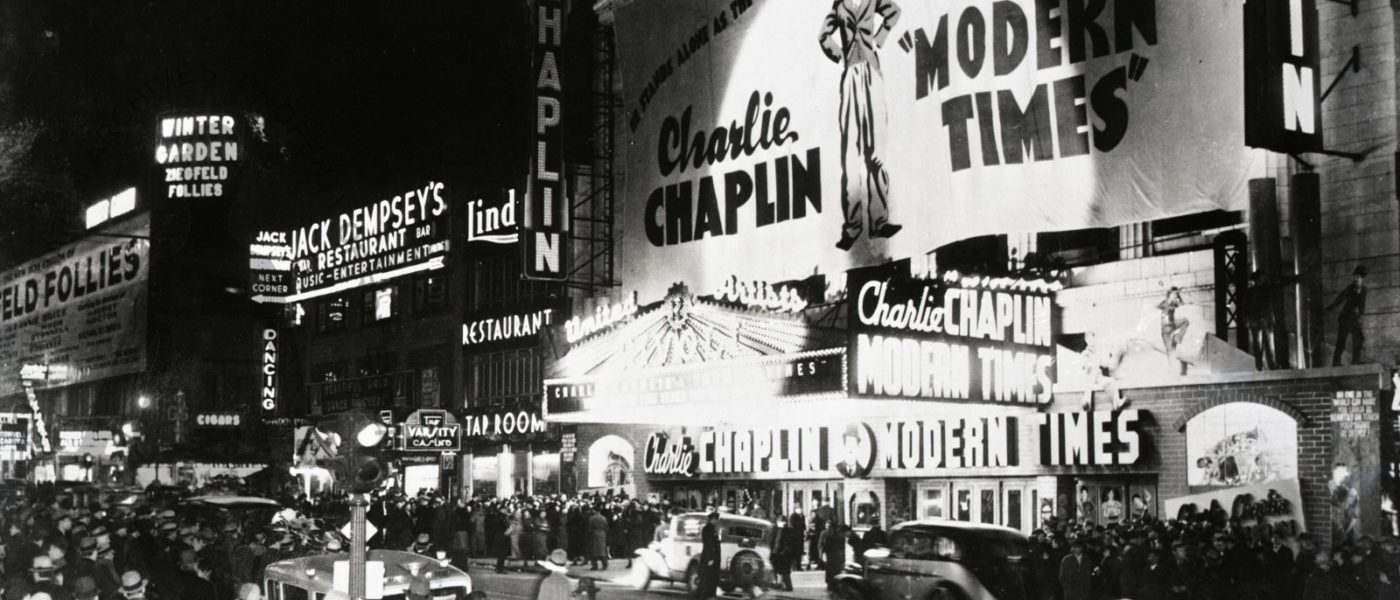When the Movies Became the Movies
ZekeFilm is 10 years old in 2022! We’re commemorating it with a year-long Film Admissions series wherein each month, we take on a decade (give or take) of cinema, in chronological order. As is always the case with Film Admissions, participants are encouraged to watch a film within that month’s topic that they’ve never seen but have been meaning to. The bigger and more well known the film, the better! Then, together, we share our individual thoughts on our findings.

While it’s true that genre on screen dates back to the very earliest days of cinema, the industry’s downright adherence to it took a few decades to calcify. While the 1920s saw said industry come together as a kind of global cash machine of prints and flicker and stars and stories to be served up with moderation or very very big, the next decade was all about finding footing.
The advent of the movie studios themselves, by then housed out west largely for weather reasons, gave way to the “studio system” of yore. Straight outta the Industrial Revolution, the institutional factory model- Taylorism, and all those such hierarchical modes- had taken on a kind of big-time uniformity. The blimey! magnitude of the “dream factories” became a Hollywood norm. By the late 1920s, Paramount, 20th Century Fox, Warner Bros., RKO and MGM had ascended the peaks and sidestepped the valleys just enough to settle in for varying long hauls of domination. This after various corporate nip/ticks of mergers, rebrandings, and capitalist evolutions. Even in a Great Depression- maybe especially in a Great Depression- the otherworldly grandiosity of it all provided some sort of far-reaching necessary flourish.

Then came the matters of studio identity. The notion that certain studios were strongly associated with very particular types of movies (and, particular types of genres) is largely lost on moviegoers of today. Warners had “ripped from the headlines” drama and crime stories, MGM did glitz and glamour, and no one did comedy like Paramount. And so it went for decades to follow. Perhaps only the names Disney and A24 carry such associative cache today. (Feel free to call out more).
This, of course, has only been a most basic bird’s eye overview of 1930s Hollywood. It says literally nothing of the similarly developing efforts elsewhere in the world, in that the allure of the “magic” of making movies has no borders. Already by the 1930s, select films were circulating around the world. And just as World War I enabled the U.S. film industry to forever take (away from France), the global lead, the war’s bigger and louder sequel would shake up everything yet again, and how. Next time for that.
Below, we take a look at our own individual 1930s Film Admissions. These are the films of the decade that we have been meaning to see and have felt that we perhaps should’ve seen prior to now. The exercise gives us the reason to do just that and share our findings with you. Please enjoy our foray into whatever swashbuckling, whatever gunslinging, whatever prohibition flaunting we have momentarily thrown ourselves back to…
– Jim Tudor
Ninotchka
Directed by Ernst Lubitsch/1939
by Jeffrey Knight
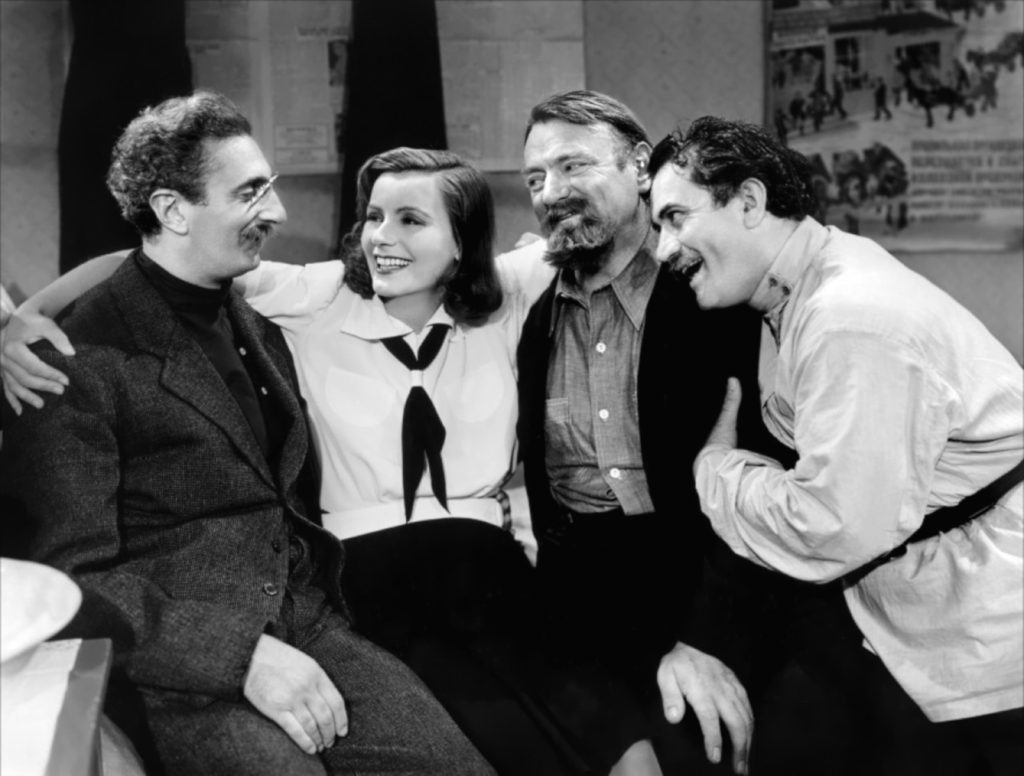
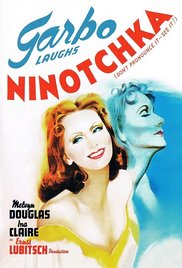
According to legend, Ninotchka‘s origin begins when screenwriter Melchior Lengyel was asked to come up with an idea for a comedy to star Greta Garbo. His pitch: “Russian girl saturated with Bolshevist ideals goes to fearful, capitalistic, monopolistic Paris. She meets romance and has an uproarious good time. Capitalism not so bad, after all.” For those three sentences, MGM would pay Lengyel $15,000 and he would be nominated for an Oscar for Best Orginal Story.
By the time Ninotchka was a finished screenplay (written by Billy Wilder, Charles Brackett, and Walter Reisch), its actual plot isn’t summed up so easily. Three Soviet agents have come to Paris to sell some jewels formerly owned by a Russian duchess, now living in exile in the French city. When word reaches her of the impending sale, her current paramour, Count Leon d’Algout (Melvyn Douglas), steps in and threatens to tie up the sale in ongoing litagation unless the Russians can come to some sort of compromise (read: pay him and the duchess a lot of money). The Russian government dispatches a stern official to take charge in Paris and complete the sale. This official, Nina Ivanovna “Ninotchka” Yakushova, played with icy ruthlessness by Greta Garbo, runs into Leon on the street. The two develop an interest in one another, that threatens to bloom into full-scale attraction before they discover they are on opposing sides of the legal dispute. Over the course of the film, Ninotchka is seduced by the charms of both Leon and life in (pre-war) Paris and slowly begins to come around on her views of the West.
The secret to Ninotchka‘s success is in its ability to thread the needle between light and sophisticated romantic comedy and it’s clear-eyed take on Stalin-era Soviet politics. When she’s asked how things are going back in Russia, she responds: “Very good. The last mass trials were a great success. There are going to be fewer but better Russians.” Leave it to Billy Wilder to make mass executions funny. At another point, Leon confesses his love of the Russian people. “I’ve been fascinated by your five-year plan for the last fifteen years,” he gushes to Ninotchka. Everyone involved in developing the film knew they could not shy away from the realities of life in the Soviet Union. When the film follows Ninotchka back to Moscow in the film’s last act, it portrays the crowded living conditions, the scarcity of food, and the abundance of paranoia that was life under the Stalinist regime. These would seem to be subjects far too grim for the sort of urbane wit director Ernst Lubitsch was known for, but his deft handling of the material coupled with the intelligent screenplay keeps the movie light and airy even as it keeps its feet on the ground.
The Grapes of Wrath
Directed by John Ford/1940
by David L. Gill
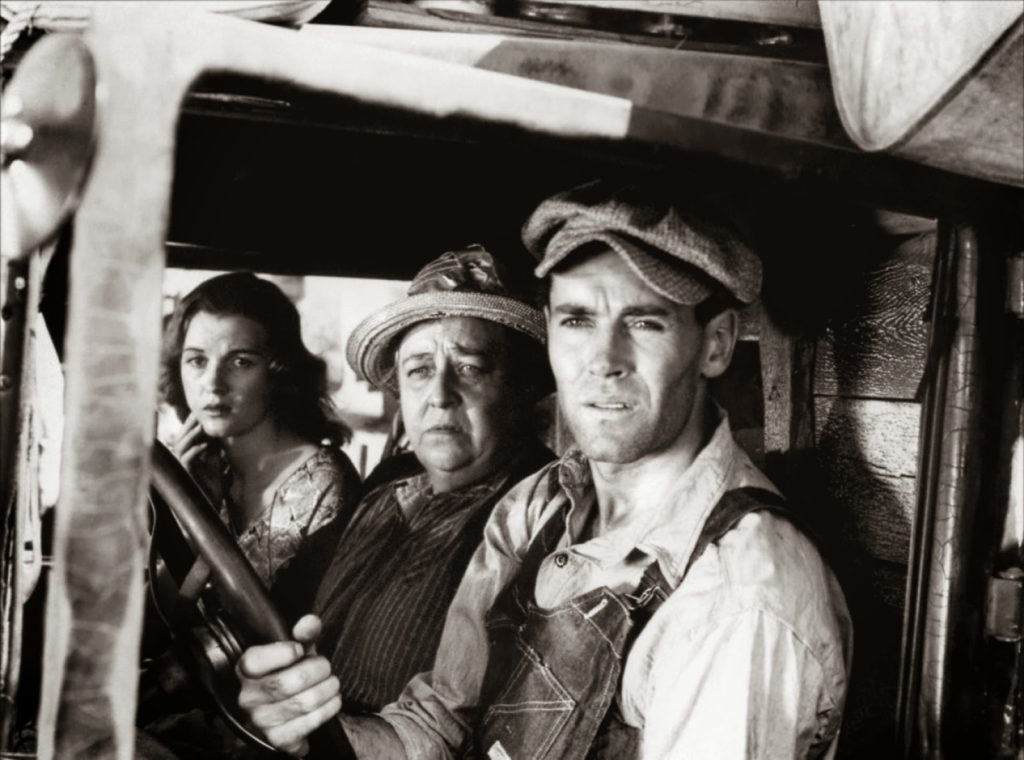
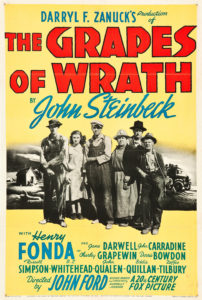
I wrestled for most of the month of April trying to figure out what film to watch for this assignment. I considered several John Ford films and even a film or two by Alfred Hitchcock. I finally settled on a story that I haven’t read since I was in high school about 25 years ago. I’d yet to ever see the film, so I pulled out my trusty Ford at Fox DVD boxed set from about fifteen years ago and put in the disc.
I spent the next two hours in tears.
The story is one of hard-working Americans who don’t own their own land being run off of it by large corporations. Tom Joad, portrayed by screen icon Henry Fonda, has just returned home from four years in prison to find his family has been evicted. After catching up with his family at his uncle’s place where that branch of the family is being similarly evicted, the family strikes out for California.
Watching the family grapple with hunger, death, and overall despair is one of the most gut-wrenching things I’ve seen in a long time. The grief in the eyes of all the characters—but especially in an amazing performance by Jane Darwell as “Ma”—was tangible and my eyes were wet almost from the beginning. Darwell was a hard-working actress who landed Best Supporting Actress for the role. She’d been in films since at least 1914 and would work until Mary Poppins, where she played the Bird Lady as her final screen role. (She was also Mrs. Merriweather in 1939’s Gone With the Wind.)I felt gutted as I watched the family go from place to place without any safety net at all. I am more convinced than ever that while the American Dream is a house and family, the American Reality is something which closely resembles the despair and poverty depicted in this film. It was a life-changing experience to see.
Roger Ebert had this to say about the film in a 2002 review:”The Grapes of Wrath shows half a nation with the economic rug pulled out from under it. The story, which seems to be about the resiliency and courage of ‘the people,’ is built on a foundation of fear: fear of losing jobs, land, self-respect. To those who had felt that fear, who had gone hungry or been homeless, it would never become dated. And its sense of injustice, I believe, is still relevant.”
With rising numbers of unhoused people in a nation with soaring house prices and vacant dwellings in the wake of men buying Twitter for $43 billion dollars and a global pandemic, I couldn’t possibly agree with that assessment more.
The Great Dictator
Directed by Charles Chaplin/1940
by Taylor Blake
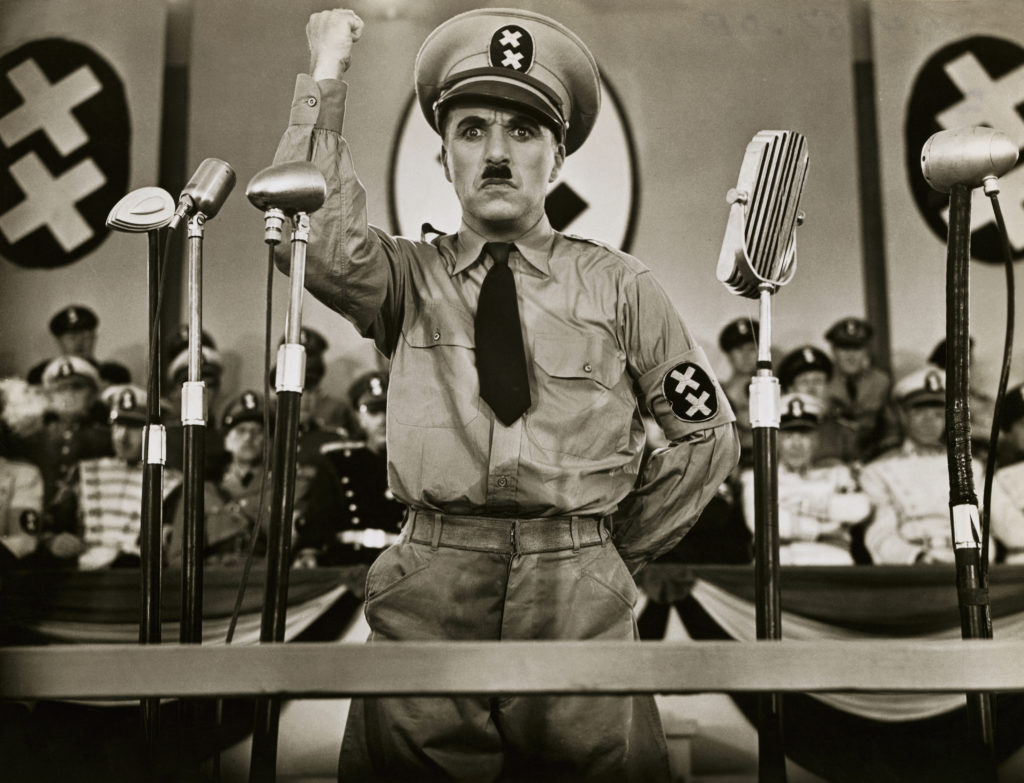
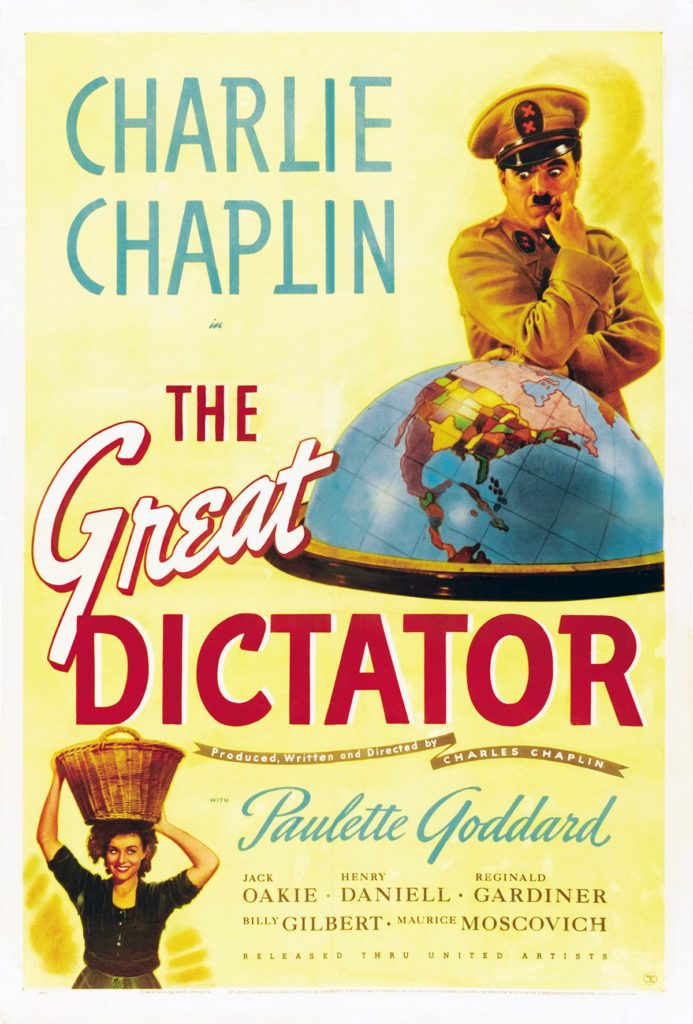
Like in March, I’m finally watching another movie I’ve seen clips from my whole life. Last month it was the first major talkie, The Jazz Singer, and this month I’m finally checking out Charlie Chaplin’s Hitler doppelgänger in The Great Dictator.
In a comedy of empiric scale, Charlie Chaplin plays dual roles as a Jewish barber and the dictator of Tomania. The barber and his wife (Paulette Godard) are falling in love and trying to make a life in a country becoming hostile to Jews while the dictator, Hynkel, is falling into a continental war and trying to make a pure Aryan race. In other hands, this 1940 film would be a tragic drama prescient of World War II, but in the hands of Chaplin, it’s a slapstick comedy about —in the words of the opening title card—the “period between two World Wars – an interim in which Insanity cut loose. Liberty took a nose dive, and Humanity was kicked around somewhat.”
Long before a doppelgänger accidentally became a major state leader in Dave and even longer before Jojo Rabbit controversially made Hitler hilarious, Chaplin infantilized and vilified the contemporary fascism on the rise in Europe. Benito Mussolini gets the same treatment in a character ruling the neighboring country of Bacteria; calling him Napaloni isn’t an attempt to veil the barbs at Mussolini’s expense—it’s another way to mock him with a word funnier every time you hear it. Like Casablanca, it’s surprising how on the nose The Great Dictator feels decades later, as well as how funny. Sight gags, pratfalls, and food fights are the artillery of these European bullies, though it’s no less than you’d expect from Chaplin. What’s more surprising after all his years of silent films is his verbal wit. The wordplay and comedic timing in his performance, his script, and his directing are pitch perfect, so much so I wonder if this silent master missed opportunities not veering into more talkies.
After the war, Chaplin said, “Had I known the actual horrors of the German concentration camps, I could not have made The Great Dictator; I could not have made fun of the homicidal insanity of the Nazis.” But with an unexpectedly sincere ending, Chaplin saved his farce from a sour legacy. I’m not sure if the speechifying criticizing fascism and prejudice at the end felt preachy in 1940, but today it covers any of the perceived offenses that might come from laughing because of genocidal dictators. Chaplin (and the rest of the world) may not have fully understood who they were facing in the Nazis, but he knew enough. He didn’t pull any punches in his comedy or leave any ambiguity in his message, which is why this this classic is both laugh-out-loud funny and poignant today.
The Count of Monte Cristo
Directed by Rowland V. Lee/1934
by Max Foizey
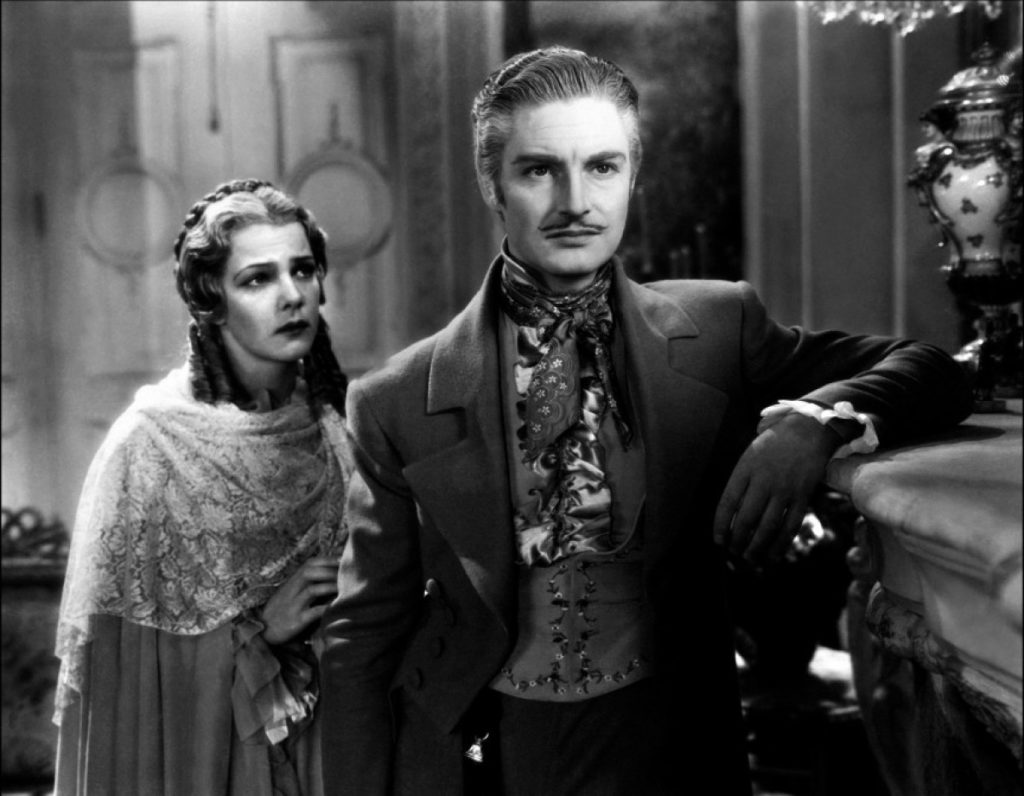
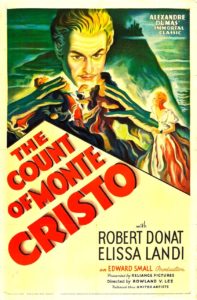
Being wronged leads to incredible rage. To be accused of something you didn’t do creates a loneliness few can comprehend. What if you were able to exact revenge on your oppressors, or better yet, justice? Clearing your name is a healing unafforded to many in life, which is no doubt why Alexandre Dumas’ novel The Count of Monte Cristo has experienced such staying power the world over since its publishing in 1844. As of this writing there have been at least eight stage, fourteen radio, twenty-three television, and twenty-four film adaptations of this tale. Every one of them has omitted characters and streamlined the book’s story, and this edition from 1934, the first talkie adaptation, is no different in that respect.
An exciting opening delivers spies, romance, the high seas, and First Officer Edmond Dantes (Robert Donat) being crossed by his contemporaries, who all have something to gain if he were to be removed from the picture. Left for dead in an island prison, the guards laugh when Edmond requests a lawyer. Time passes slowly until Edmond meets an elderly prisoner who has spent years surreptitiously digging an escape tunnel. The old man becomes a mentor to Edmond and tells of a fortune waiting to be claimed should they escape. The old man warns Edmond to use the money not for revenge, but justice.
Believing Edmond dead, his beloved Mercedes (Elissa Landi) agrees to marry Fernand Mondego (Sidney Blackmer), unaware that he is one of the men responsible for Edmond’s imprisonment. She imagines it’s Edmond standing before her as she says her marriage vows, her love for him not faded. Director Rowland V. Lee favors many close ups of Mercedes, and with good reason, Elissa Landi makes great use of her face to convey to the audience just what she suspects as the story unfolds. Sidney Blackmer proves a grand heel as the villainous Mondego, a character the audience enjoys rooting against from his introduction. Robert Donat, so wonderful in Alfred Hitchcock’s The 39 Steps, does a lot with subtle mannerisms, unlike the popular outsized acting of some of his contemporaries. He is very endearing as the young, idealistic Edmond and quite resolute as the commanding, calculating Count.
The pleasure in the film comes from watching Edmond’s ingenious plan slowly come to fruition, as he gradually entrenches himself with his enemies, ensuring his delicious victory inches ever closer. The production values are second-to-none for this era, especially the opening scenes of a ship caught in a violent storm. If you can forgive Alfred Newman’s overwrought score and a courtroom denouement that is a bit too long, you’ll be sure to enjoy this engrossing retelling of The Count of Monte Cristo.
L’Atalante
Directed by Jean Vigo/1934
by Robert Hornak
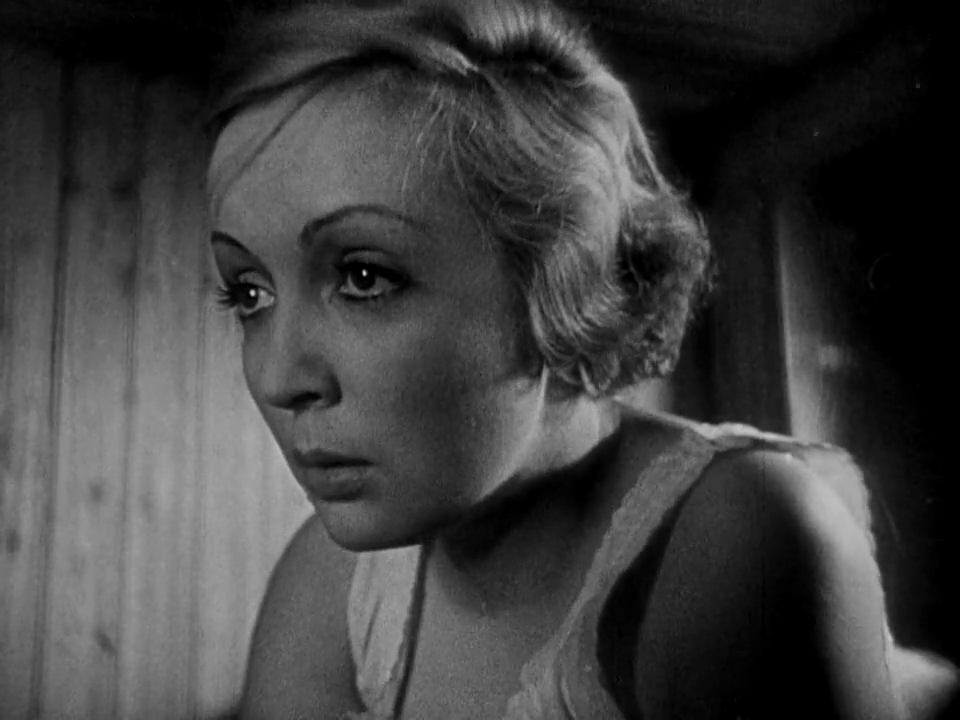
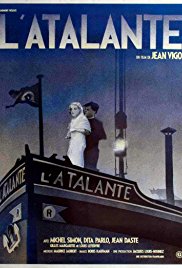
Sometimes there is a challenge. I spend a good portion of every semester trying to convince students to look beyond their initial rush of boredom when I play movies that sport triggering aspects like, say, black and white photography or, let’s also say, subtitles, or, let’s go ahead and round it out with, maybe, the fact of its being made long before anyone in the room’s grandparents were born. And yet here I am. Staring at this movie, so revered, so honored, so ensconced near the top of the cinematic pile, if the “greatest” lists are to be believed, and yet so inert and plodding, save for a couple of choice sequences, that I simply and humbly don’t get it. Some might say, “Film professor, heal thyself,” and I’d be inclined to say, “Yeah, I know, right?”
After all, the movie is simple and straightforward enough, asking the proverbial question: What would you do if after your wedding, your husband took you on a honeymoon – to his job? And what if his job was being captain of a delivery barge up and down the Seine River? Well, from that premise I might expect a comedy. And it is a comedy, in a certain manner. Maybe in the way that an Aesop fable is a comedy of human foibles, or in the way that a parable of Jesus is a comedy of mankind’s tendency toward shallowness and mendacity, or in the way that any premise that puts the inevitable strife of marriage or – for that matter – any attempt at male-female compromise in terms simple enough that a stand-up comic could get a chuckle or two.
But somehow, bottled up as this one is in the unremarkable shape of these two particular betrothed ones, so standard in their reactions toward one another – the emotional depths implied by their scenario are not plumbed but skimmed – I’m left to bob alongside the boat watching the peripheral landmarks of this beloved work to get my thrills. These include the inescapably palpable presence (at least by comparison) of the great Michel Simon, who, only two years before, had saturated the screen with his ambling charm in the rags of the homeless, suicidal, and eternally rapacious Boudu in Jean Renoir’s brilliantly satirical film. Here, he offers up a similarly beguiling earthiness, forever shiny from the briny sweat of his profession (essentially, barge dweller), but filled to up above his matted cap with a growling humanity and wisdom that reaches past his own preferred mudded stasis to enact a kind of salvation for the troubled lovebirds onboard. Watching him is to watch the heart of the film, or maybe the soul saving grace of the film.
Meanwhile, there is director Jean Vigo’s visual flare, showing up in many lustrous moments to convey a certain sense of dreamlike escape or else nightmarish anguish. Those moments, crafted by a young director famously ill (he died near the release of the film at the age of 29), are layered with the knowledge of his tragically truncated biography and his iconoclastic penchant, as if to say this is how you portray romantic separation. The young lady’s walk along the top of the boat near the beginning of the film can shock us by how much the cheaply dated visual effect actually helps convey the enormity of her confusion and aloneness in that moment. Later, the two lovers’ writhing in their separate, long-distanced beds, their images dissolved over each other, is so evocatively French in its sexual frankness that the moment nearly reclaims and redeems the languishing story that precedes it.
I’ve nearly convinced myself of the movie’s greatness – but, no. These are isolated bits that would fit in a celebratory flip-book of Vigo’s innate cinematic gifts. But they don’t hold up for me across the ninety minutes of loose fable. I need someone to hold my hand through the next viewing, helping me to not wander off distractedly into the city in search of something better.
Frontier Marshal
Directed by Allan Dwan/1939
by Jim Tudor
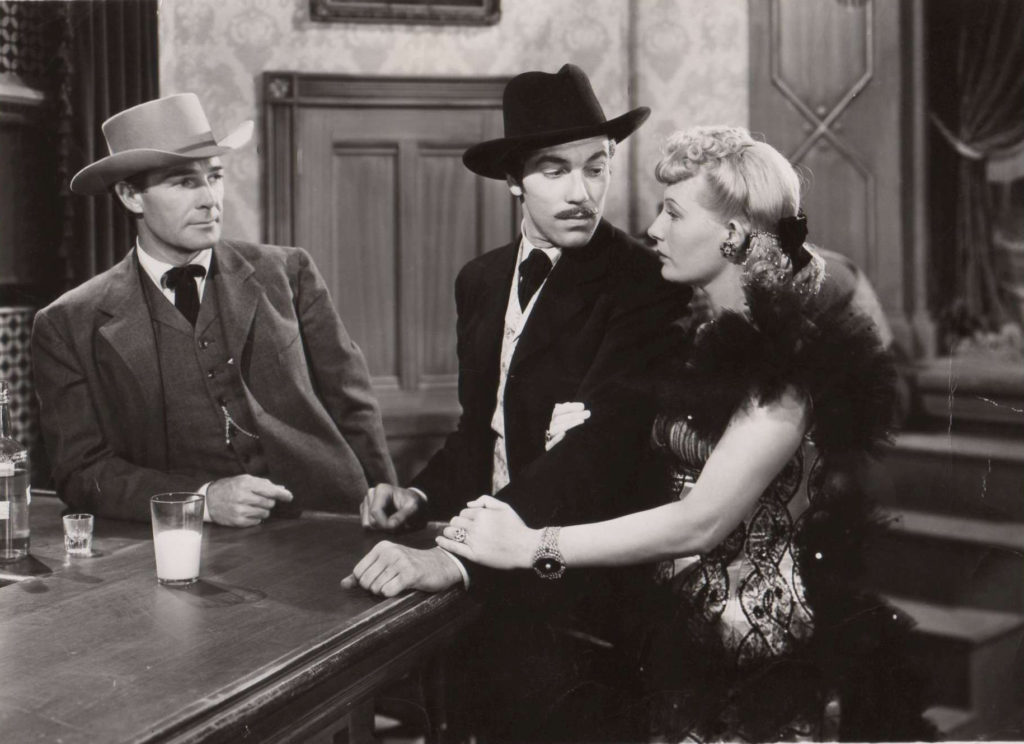
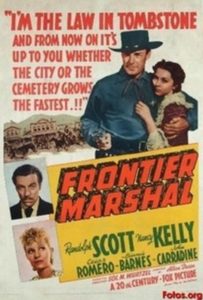
Last month, I wrote up John Ford’s The Iron Horse as my submission for ZekeFilm’s 1920’s edition of Film Admissions. Seeing that film involved getting into the old, formidably large “Ford at Fox” DVD box set. To mind came a strange black sheep of that amazing set, Allan Dwan’s 1939 Wyatt Earp yarn, Frontier Marshal. Serving as distinct inspiration for Ford’s own Earp classic, My Darling Clementine (1946), this Randolph Scott starrer was deemed essential enough to warrant inclusion the big box. It wound up being a mail-away freebie for purchasers of the set, housed only in a paper sleeve. Consequently, my copy of Frontier Marshal has been lost in my movie collection off and on for a decade and a half. When it turned up again recently, I knew that now was the time to finally watch this elusive entry in the Wyatt Earp movie canon.
In its deluge of not-even-trying-to-be-accurate historical reach-backs, the is quite film clever in its extensive use of legendary comedy performer Eddie Foy. Played here by Foy’s real-life son, Eddie Foy Jr., the popular entertainer finds himself the impetus for escalating tensions between trigger-happy factions in the newly sprung-up and bustling Tombstone, Arizona. But that’s just singin’ n’ dancing window dressing for getting the titular frontier marshal to the film’s showdown. And if you were to guess that that showdown was at the O-K Corral, you’d be spot-on. Never mind that it was Virgil Earp, not Wyatt Earp who was the Earp marshal of Tombstone (no mention of any other Earps in this film), here Dwan and company happily print the legend of Wyatt (Scott) as a singularly heroic Western gunslinger.
As an idealized Wyatt Earp, Randolph Scott is plenty ideal. More-so than most Western actors of the time, Scott exuded a kind of everyman nobility mixed in with his easy self-assuredness. His presence in the lead unquestionably elevates the already well above-average Frontier Marshal. Director Dwan certainly knew what he was doing by 1939, seeing’s how he’d been at it since the earlier end of the silent era. Why Earp’s trusty sideman is “Doc Halliday” in this film as opposed to “Doc Holliday, I can’t rightly say, though it may or may not have something to do with the disputes and lawsuits between the studio and the late Wyatt Earp’s wife, Josephine. Mrs. Earp, it’s said, didn’t appreciate Fox’s previous take (a 1934 film also called “Frontier Marshal”) on her late husband’s largely full-of-horse-manure biography, Wyatt Earp: Frontier Marshal by Stuart Lake. It was smoothed over with payment of a few thousand dollars and the removal of “Wyatt Earp” from the title.
Dwan’s Frontier Marshal is currently unavailable on all streaming platforms, with only an old Fox “Cinema Archives” DVD available for purchase. If, however, you do somehow find yourself in a position to see it, you will likely not at all be disappointed. Cesar Romero plays Halliday, who in this universe, was actually a full-on doctor (as opposed to Holliday’s dentistry profession). Halliday enters the film late, dragging the other two corners of his damaged love triangle behind him (the nice one played by Nancy Kelly, the dancehall girl played by Binnie Barnes). It’s his story that ends up dominating the film. Dwan’s Tombstone is quite fired up with impressive supporting actors. Look for Ward Bond, Lon Cheney Jr., John Carradine, Edward Norris and Chris-Pin Martin in small roles.


